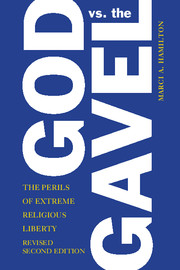Book contents
- Frontmatter
- Contents
- Acknowledgments
- Preface to the Second Edition
- Introduction: The Wages of RFRA
- Part One Religious Liberty is not a License to Harm Others
- Part Two The History and Doctrine Behind Common-Sense Religious Liberty
- 8 Ordered Liberty: Religious Liberty at the Supreme Court
- 9 The Decline of Church Autonomy and the Rise of the No-Harm Rule
- 10 The Path to the Public Good
- Epilogue: Follow the Money
- Foreword to the 2005 Edition
- Notes
- Index
9 - The Decline of Church Autonomy and the Rise of the No-Harm Rule
Published online by Cambridge University Press: 05 November 2014
- Frontmatter
- Contents
- Acknowledgments
- Preface to the Second Edition
- Introduction: The Wages of RFRA
- Part One Religious Liberty is not a License to Harm Others
- Part Two The History and Doctrine Behind Common-Sense Religious Liberty
- 8 Ordered Liberty: Religious Liberty at the Supreme Court
- 9 The Decline of Church Autonomy and the Rise of the No-Harm Rule
- 10 The Path to the Public Good
- Epilogue: Follow the Money
- Foreword to the 2005 Edition
- Notes
- Index
Summary
There has been an ongoing dialectic among religious entities, the law, and the public good in the West for centuries. This history begins with strong privileges for religious entities and moves toward a requirement that they may not have others anymore than anyone else. This play of power has yielded a legal construct that reflects lessons learned. As Justice Oliver Wendell Holmes said, “the life of the law has not been logic: it has been experience.”
There was a time in Anglo-American history when established religious entities were sovereign and the clergy enjoyed special treatment under the law. It would have come as no surprise to anyone that the established religious institution was immune to the requirements of the law or that clergy were relieved of its requirements while all other citizens were not. A citizen could be put to death for raping a child, while a clergy member could commit the same crime and be sentenced to a year at a monastery.
That era, however, was centuries ago. Today, the rule in the United States is that every entity – including a religious entity – is subject to the law.
- Type
- Chapter
- Information
- God vs. the GavelThe Perils of Extreme Religious Liberty, pp. 278 - 313Publisher: Cambridge University PressPrint publication year: 2014



